 | –≠–ª–µ–∫—Ç—Ä–æ–Ω–Ω—ã–π –∫–æ–º–ø–æ–Ω–µ–Ω—Ç: LT1008MJ8 | –°–∫–∞—á–∞—Ç—å:  PDF PDF  ZIP ZIP |
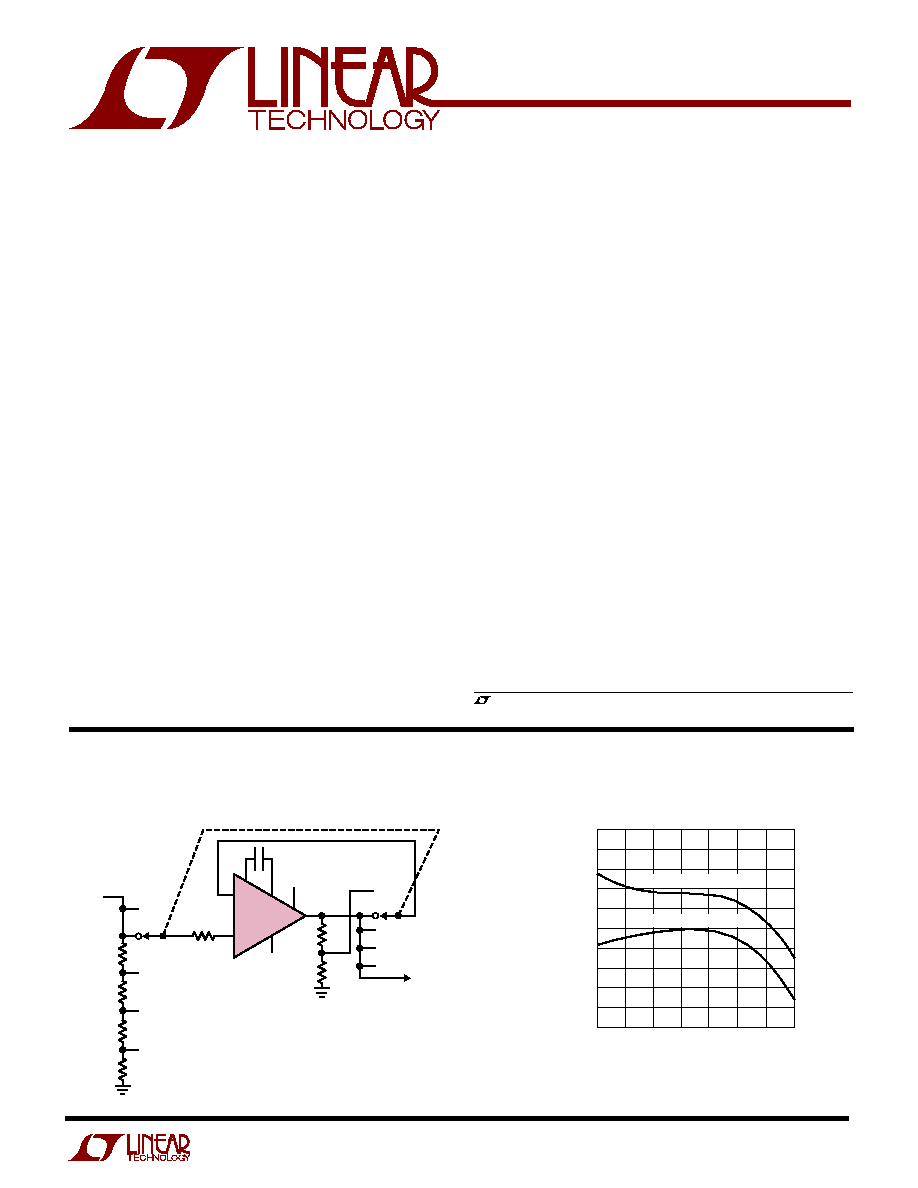
1
LT1008
Picoamp Input Current,
Microvolt Offset,
Low Noise Op Amp
The LT
Æ
1008 is a universal precision operational amplifier
that can be used in practically all precision applications.
The LT1008 combines for the first time, picoampere bias
currents (which are maintained over the full ≠ 55
∞
C to
125
∞
C temperature range), microvolt offset voltage (and
low drift with time and temperature), low voltage and
current noise, and low power dissipation. Extremely high
common mode and power supply rejection ratios, and the
ability to deliver 5mA load current with high voltage gain
round out the LT1008's superb precision specifications.
The all around excellence of the LT1008 eliminates the
necessity of the time consuming error analysis procedure
of precision system design in many applications; the
LT1008 can be stocked as the universal precision op amp.
The LT1008 is externally compensated with a single ca-
pacitor for additional flexibility in shaping the frequency
response of the amplifier. It plugs into and upgrades all
standard LM108A/LM308A applications. For an internally
compensated version with even lower offset voltage but
otherwise similar performance see the LT1012.
s
Guaranteed Bias Current
T
A
= 25
∞
C: 100pA Max
T
A
= ≠ 55
∞
C to 125
∞
C: 600pA Max
s
Guaranteed Offset Voltage: 120
µ
V Max
s
Guaranteed Drift: 1.5
µ
V/
∞
C Max
s
Low Noise, 0.1Hz to 10Hz: 0.5
µ
V
P-P
s
Guaranteed Low Supply Current: 600
µ
A Max
s
Guaranteed CMRR: 114dB Min
s
Guaranteed PSRR: 114dB Min
s
Guaranteed Voltage Gain with 5mA Load Current
s
Precision Instrumentation
s
Charge Integrators
s
Wide Dynamic Range Logarithmic Amplifiers
s
Light Meters
s
Low Frequency Active Filters
s
Standard Cell Buffers
s
Thermocouple Amplifiers
Input Amplifier for 4.5 Digit Voltmeter
FEATURES
DESCRIPTIO
U
APPLICATIO S
U
TYPICAL APPLICATIO
U
≠
+
LT1008
1
1000pF
2
3
100k
5%
8
4
7
15V
≠15V
6
0.1V
INPUT
1V
10V
10V
1V
100V
1000V
1008 TA01
TO 1V FULL-SCALE
ANALOG-TO-DIGITAL
CONVERTER
*RATIO MATCH
±
0.01%
9M
100V
900k
9k*
0.1V
1k*
1000V
FN507
ALLEN BRADLEY
DECADE VOLTAGE DIVIDER
THIS APPLICATION REQUIRES LOW
BIAS CURRENT AND OFFSET VOLTAGE,
LOW NOISE AND LOW DRIFT WITH
TIME AND TEMPERATURE
90k
10k
TEMPERATURE (
∞
C)
≠50
≠150
INPUT BIAS CURRENT (pA)
≠50
100
0
50
75
1008 TA02
≠100
50
0
≠25
25
100
125
UNDERCANCELLED UNIT
OVERCANCELLED UNIT
Input Bias Current vs Temperature
, LTC and LT are registered trademarks of Linear Technology Corporation.
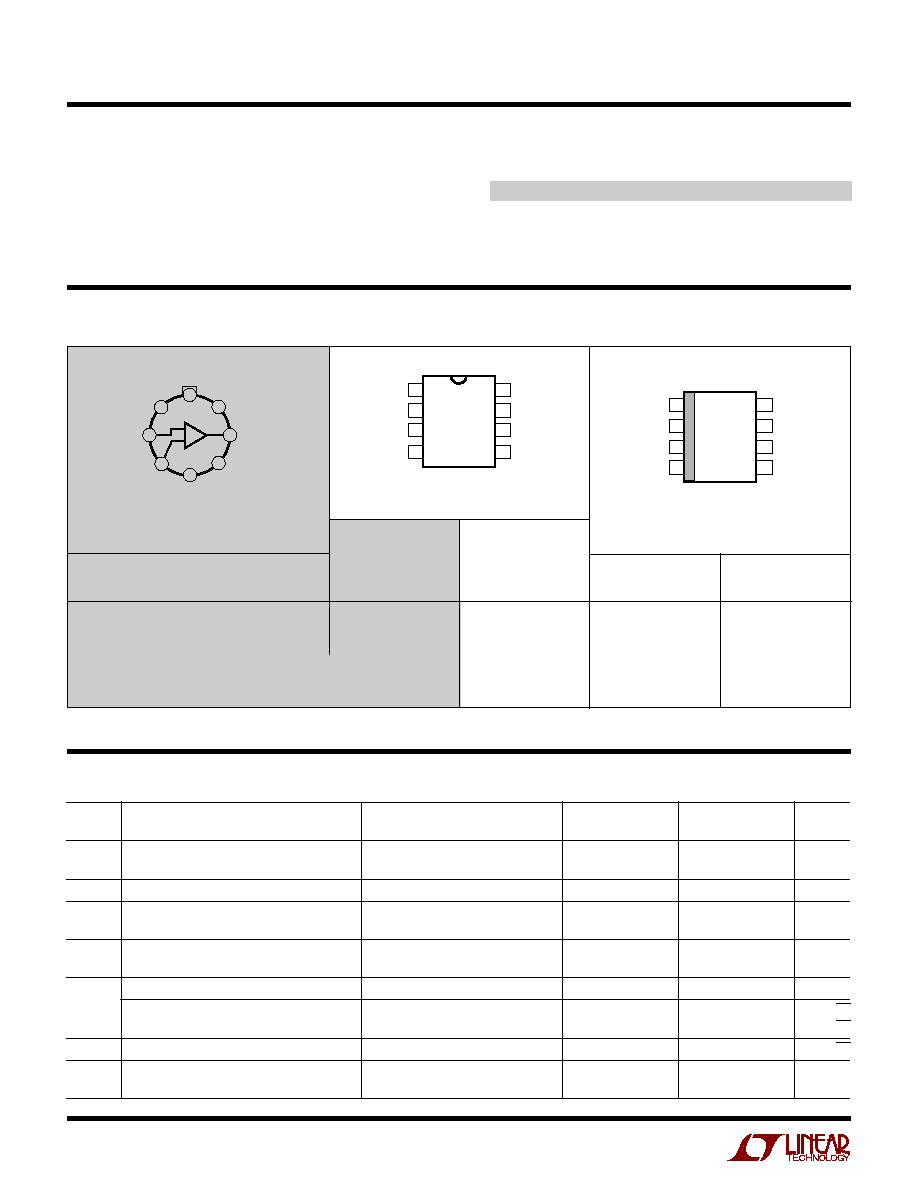
2
LT1008
(Note 1)
Supply Voltage ......................................................
±
20V
Differential Input Current (Note 2) .....................
±
10mA
Input Voltage ........................................................
±
20V
Output Short-Circuit Duration ......................... Indefinite
Storage Temperature Range ................. ≠ 65
∞
C to 150
∞
C
ABSOLUTE AXI U RATI GS
W
W
W
U
PACKAGE/ORDER I FOR ATIO
U
U
W
ORDER PART
NUMBER
LT1008MH
LT1008CH
T
JMAX
= 150
∞
C,
JA
= 150
∞
C/W,
JC
= 45
∞
C/W
T
JMAX
= 150
∞
C,
JA
= 130
∞
C/W
Operating Temperature Range
LT1008M (OBSOLETE) ............... ≠ 55
∞
C to 125
∞
C
LT1008C ................................................. 0
∞
C to 70
∞
C
LT1008I ............................................. ≠ 40
∞
C to 85
∞
C
Lead Temperature (Soldering, 10 sec).................. 300
∞
C
TOP VIEW
V
+
COMP2
COMP1
≠IN
OUT
NC
+IN
V
≠
(CASE)
8
7
6
5
3
2
1
4
H PACKAGE
8-LEAD TO-5 METAL CAN
+
≠
1
2
3
4
8
7
6
5
TOP VIEW
COMP1
≠IN
+IN
V
≠
COMP2
V
+
OUT
NC
N8 PACKAGE
8-LEAD PDIP
LT1008MJ8
LT1008CJ8
J8 PACKAGE 8-LEAD CERDIP
T
JMAX
= 150
∞
C,
JA
= 100
∞
C/W
1
2
3
4
8
7
6
5
TOP VIEW
COMP2
V
+
OUT
NC
COMP1
≠IN
+IN
V
≠
S8 PACKAGE
8-LEAD PLASTIC SO
T
JMAX
= 150
∞
C,
JA
= 190
∞
C/W
OBSOLETE PACKAGES
ORDER PART
NUMBER
LT1008S8
S8 PART
MARKING
1008
LT1008M/I
LT1008C
SYMBOL
PARAMETER
CONDITIONS
MIN
TYP
MAX
MIN
TYP
MAX
UNITS
V
OS
Input Offset Voltage
30
120
30
120
µ
V
(Note 3)
40
180
40
180
µ
V
Long-Term Input Offset Voltage Stability
0.3
0.3
µ
V/Month
I
OS
Input Offset Current
30
100
30
100
pA
(Note 4)
40
150
40
150
pA
I
B
Input Bias Current
±
30
±
100
±
30
±
100
pA
(Note 5)
±
40
±
150
±
40
±
150
pA
e
n
Input Noise Voltage
0.1Hz to 10Hz
0.5
0.5
µ
V
P-P
Input Noise Voltage Density
f
O
= 10Hz (Note 4)
17
30
17
30
nV
Hz
f
O
= 1000Hz (Note 5)
14
22
14
22
nV/
Hz
i
n
Input Noise Current Density
f
O
= 10Hz
20
20
fA/
Hz
A
VOL
Large-Signal Voltage Gain
V
OUT
=
±
12V, R
L
10k
200
2000
200
2000
V/mV
V
OUT
=
±
10V, R
L
2k
120
600
120
600
V/mV
ELECTRICAL CHARACTERISTICS
V
S
=
±
15V, V
CM
= 0V, T
A
= 25
∞
C, unless otherwise noted.
Consult LTC Marketing for parts specified with wider operating temperature ranges.
ORDER PART
NUMBER
LT1008CN8
LT1008IN8
ORDER PART
NUMBER
Consider N8 or S8 Package for Alternate Source
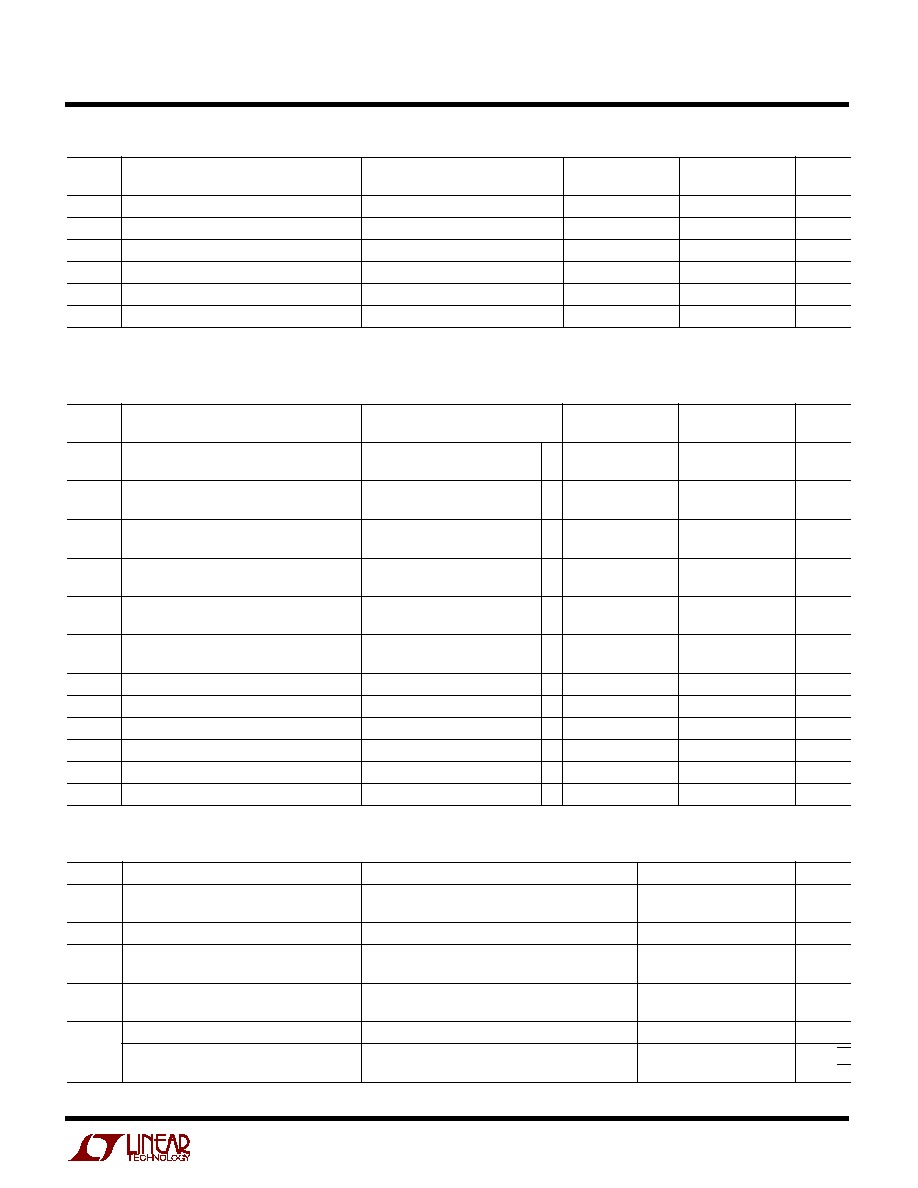
3
LT1008
The
q
indicates specifications which apply over the full operating temperature range of ≠ 55
∞
C
T
A
125
∞
C for the LT1008M, ≠ 40
∞
C
T
A
85
∞
C for the LT1008I and 0
∞
C
T
A
70
∞
C for the LT1008C. V
S
=
±
15V, V
CM
= 0V, unless otherwise noted.
LT1008M/I
LT1008C
SYMBOL
PARAMETER
CONDITIONS
MIN
TYP
MAX
MIN
TYP
MAX
UNITS
V
OS
Input Offset Voltage
q
50
250
40
180
µ
V
(Note 3)
q
60
320
50
250
µ
V
Average Temperature Coefficient of
Input Offset Voltage
q
0.2
1.5
0.2
1.5
µ
V/
∞
C
I
OS
Input Offset Current
q
60
250
40
180
pA
(Note 3)
q
80
350
50
250
pA
Average Temperature Coefficient of
Input Offset Current
q
0.4
2.5
0.4
2.5
pA/
∞
C
I
B
Input Bias Current
q
±
80
±
600
±
40
±
180
pA
(Note 3)
q
±
150
±
800
±
50
±
250
pA
Average Temperature Coefficient of
Input Bias Current
q
0.6
6
0.4
2.5
pA/
∞
C
A
VOL
Large-Signal Voltage Gain
V
OUT
=
±
12V, R
L
10k
q
100
1000
150
1500
V/mV
CMRR
Common Mode Rejection Ratio
V
CM
=
±
13.5V
q
108
128
110
130
dB
PSRR
Power Supply Rejection Ratio
V
S
=
±
2.5V to
±
20V
q
108
126
110
128
dB
Input Voltage Range
q
±
13.5
±
13.5
V
V
OUT
Output Voltage Swing
R
L
= 10k
q
±
13
±
14
±
13
±
14
V
I
S
Supply Current
q
400
800
400
800
µ
A
ELECTRICAL CHARACTERISTICS
V
S
=
±
15V, V
CM
= 0V, T
A
= 25
∞
C, unless otherwise noted.
LT1008M/I
LT1008C
SYMBOL
PARAMETER
CONDITIONS
MIN
TYP
MAX
MIN
TYP
MAX
UNITS
CMRR
Common Mode Rejection Ratio
V
CM
=
±
13.5V
114
132
114
132
dB
PSRR
Power Supply Rejection Ratio
V
S
=
±
2V to
±
20V
114
132
114
132
dB
Input Voltage Range
±
13.5
±
14
±
13.5
±
14
V
V
OUT
Output Voltage Swing
R
L
= 10k
±
13
±
14
±
13
±
14
V
Slew Rate
C
F
= 30pF
0.1
0.2
0.1
0.2
V/
µ
s
I
S
Supply Current
(Note 3)
380
600
380
600
µ
A
SYMBOL
PARAMETER
CONDITIONS
MIN
TYP
MAX
UNITS
V
OS
Input Offset Voltage
30
200
µ
V
(Note 3)
40
250
µ
V
Long-Term Input Offset Voltage Stability
0.3
µ
V/Month
I
OS
Input Offset Current
100
280
pA
(Note 3)
120
380
pA
I
B
Input Bias Current
±
100
±
300
pA
(Note 3)
±
120
±
400
pA
e
n
Input Noise Voltage
0.1Hz to 10Hz
0.5
µ
V
P-P
Input Noise Voltage Density
f
O
= 10Hz (Note 5)
17
30
nV/
Hz
f
O
= 1000Hz (Note 5)
14
22
nV/
Hz
(LT1008S8 only) V
S
=
±
15V, V
CM
= 0V, T
A
= 25
∞
C, unless otherwise noted.
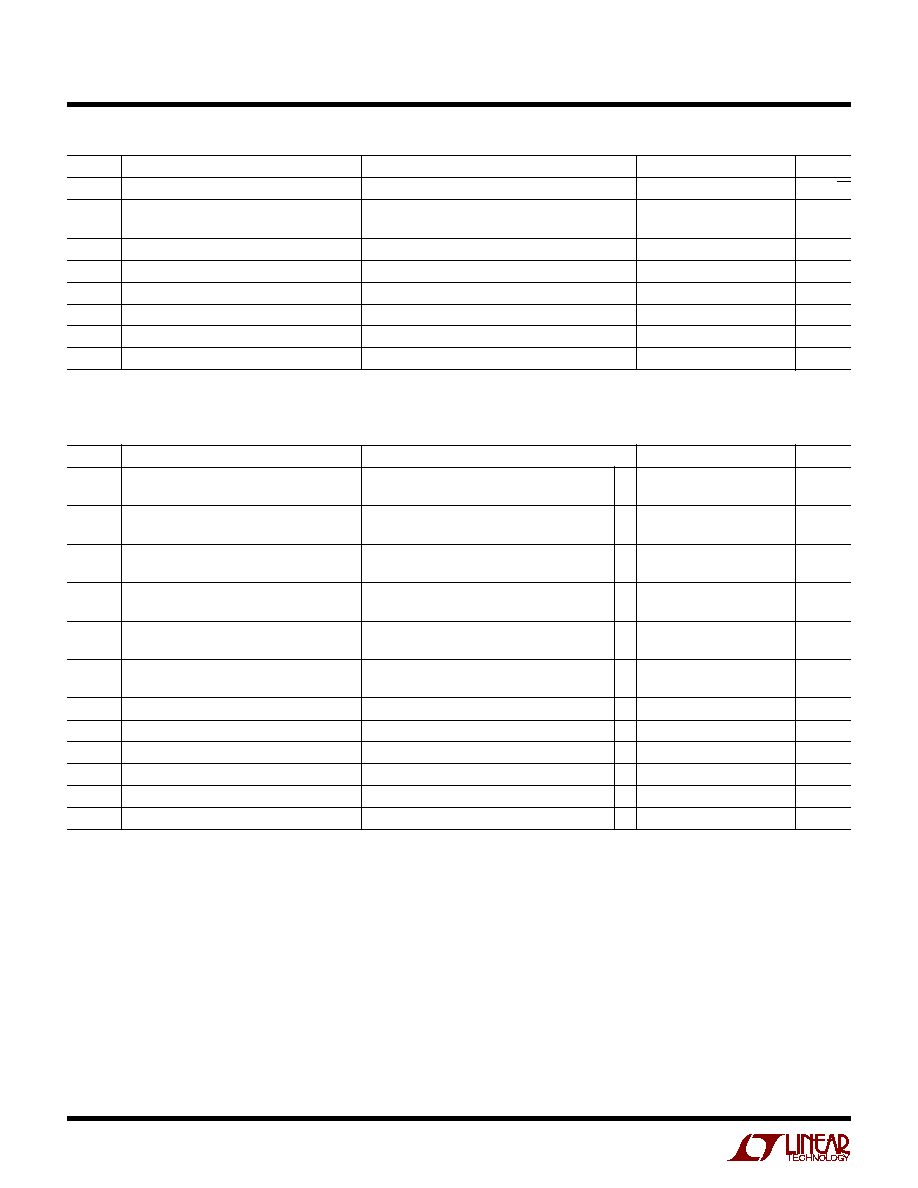
4
LT1008
SYMBOL
PARAMETER
CONDITIONS
MIN
TYP
MAX
UNITS
i
n
Input Noise Current Density
f
O
= 10Hz
20
fA/
Hz
A
VOL
Large-Signal Voltage Gain
V
OUT
=
±
12V, R
L
10k
200
2000
V/mV
V
OUT
=
±
10V, R
L
2k
120
600
V/mV
CMRR
Common Mode Rejection Ratio
V
CM
=
±
13.5V
110
132
dB
PSRR
Power Supply Rejection Ratio
V
S
=
±
2V to
±
20V
110
132
dB
Input Voltage Range
±
13.5
±
14
V
V
OUT
Output Voltage Swing
R
L
= 10k
±
13
±
14
V
Slew Rate
C
F
= 30pF
0.1
0.2
V/
µ
s
I
S
Supply Current
(Note 3)
380
600
µ
A
ELECTRICAL CHARACTERISTICS
(LT1008S8 only) V
S
=
±
15V, V
CM
= 0V, T
A
= 25
∞
C, unless otherwise noted.
(LT1008S8 only) The
q
indicates specifications which apply over the full operating temperature range of 0
∞
C
T
A
70
∞
C.
V
S
=
±
15V, V
CM
= 0V, unless otherwise noted.
SYMBOL
PARAMETER
CONDITIONS
MIN
TYP
MAX
UNITS
V
OS
Input Offset Voltage
q
40
280
µ
V
(Note 3)
q
50
340
µ
V
Average Temperature Coefficient of
q
0.2
1.8
µ
V/
∞
C
Input Offset Voltage
I
OS
Input Offset Current
q
120
380
pA
(Note 3)
q
140
500
pA
Average Temperature Coefficient of
q
0.4
4
pA/
∞
C
Input Offset Current
I
B
Input Bias Current
q
±
120
±
420
pA
(Note 3)
q
±
140
±
550
pA
Average Temperature Coefficient of
q
0.4
5
pA/
∞
C
Input Bias Current
A
VOL
Large-Signal Voltage Gain
V
OUT
=
±
12V, R
L
10k
q
150
1500
V/mV
CMRR
Common Mode Rejection Ratio
V
CM
=
±
13.5V
q
108
130
dB
PSRR
Power Supply Rejection Ratio
V
S
=
±
2.5V to
±
20V
q
108
128
dB
Input Voltage Range
q
±
13.5
V
V
OUT
Output Voltage Swing
R
L
= 10k
q
±
13
±
14
V
I
S
Supply Current
q
400
800
µ
A
Note 1: Absolute Maximum Ratings are those values beyond which the life
of a device may be impaired.
Note 2: Differential input voltages greater than 1V will cause excessive
current to flow through the input protection diodes unless current limiting
resistors are used.
Note 3: These specifications apply for
±
2V
V
S
±
20V
(
±
2.5V
V
S
±
20V over the temperature range) and
≠13.5V
V
CM
13.5V (for V
S
=
±
15V).
Note 4: 10Hz noise voltage density is sample tested on every lot. Devices
100% tested at 10Hz are available on request.
Note 5: This parameter is tested on a sample basis only.
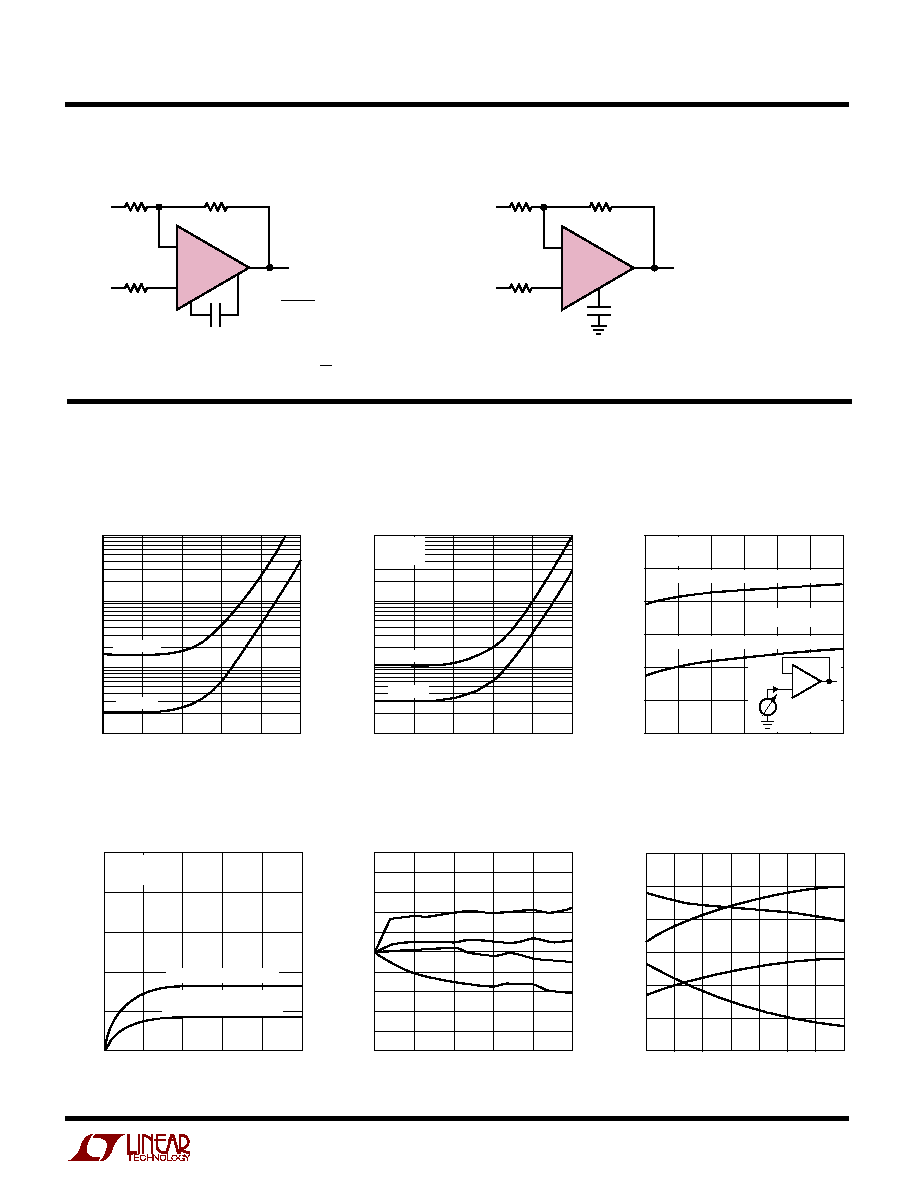
5
LT1008
TYPICAL PERFOR A CE CHARACTERISTICS
U
W
Offset Voltage Drift vs Source
Resistance (Balanced or
Unbalanced)
Input Bias Current vs
Common Mode Range
Warm-Up Drift
Long-Term Stability of Four
Representative Units
Offset Voltage Drift with
Temperature of Four
Representative Units
SOURCE RESISTANCE (
)
1k
10k
0.1
OFFSET VOLTAGE DRIFT WITH TEMPERATURE (
µ
V/
∞
C)
10
100
100k
1M
10M
100M
1008 G01
1
MAXIMUM
TYPICAL
SOURCE RESISTANCE (
)
1k
10k
0.01
INPUT OFFSET VOLTAGE (mV)
1
10
100k
1M
10M
100M
1008 G02
0.1
MAXIMUM
TYPICAL
V
S
=
±
15V
T
A
= 25
∞
C
COMMON MODE INPUT VOLTAGE (V)
≠15
≠60
INPUT BIAS CURRENT (pA)
≠40
≠20
0
20
60
≠10
≠ 5
0
5
1008 G03
10
15
40
+
≠
I
B
V
CM
DEVICE WITH POSITIVE INPUT CURRENT
DEVICE WITH NEGATIVE INPUT CURRENT
V
S
=
±
15V
T
A
= 25
∞
C
R
INCM
= 2
◊
10
12
Offset Voltage vs Source
Resistance (Balanced or
Unbalanced)
TEMPERATURE (
∞
C)
≠50
OFFSET VOLTAGE (
µ
V)
20
40
60
25
75
1008 G06
0
≠20
≠25
0
50
100
125
≠40
≠60
TIME (MONTHS)
0
CHANGE IN OFFSET VOLTAGE (
µ
V)
2
6
10
4
1008 G05
≠2
≠6
0
4
8
≠4
≠8
≠10
1
2
3
5
TIME AFTER POWER ON (MINUTES)
0
CHANGE IN OFFSET VOLTAGE (
µ
V)
3
4
5
4
1008 G04
2
1
0
1
2
3
5
METAL CAN (H) PACKAGE
DUAL-IN-LINE PACKAGE
PLASTIC (N) OR CERDIP (J)
V
S
=
±
15V
T
A
= 25
∞
C
U
W
FREQUE CY CO PE SATIO CIRCUITS
U
U
≠
+
LT1008
6
V
OUT
1
8
R1C
O
R1 + R2
C
F
C
O
= 30pF
2
3
**BANDWIDTH AND SLEW RATE
ARE PROPORTIONAL TO 1/C
F
R3
C
F
**
R1
R2
+V
IN
≠V
IN
1008 FCC01
≠
+
LT1008
6
V
OUT
1008 FCC02
8
2
3
**BANDWIDTH AND SLEW RATE ARE
PROPORTIONAL TO 1/C
S
*IMPROVES REJECTION OF POWER
SUPPLY NOISE BY A FACTOR OF 5
C
S
**
100pF
R1
R2
+V
IN
≠V
IN
FOR
> 200, NO EXTERNAL FREQUENCY COMPENSATION IS NECESSARY
R2
R1
Standard Compensation Circuit
Alternate* Frequency Compensation




